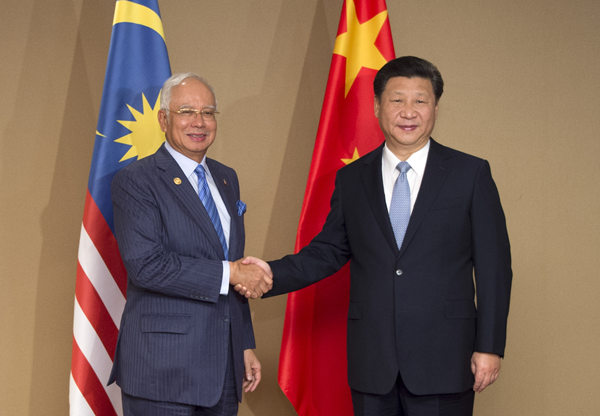Port investment shows Belt and Road vigor
Updated: 2016-07-06 07:12
(China Daily)
|
|||||||||
 |
|
Chinese President Xi Jinping (R) meets with Malaysian Prime Minister Najib Razak in Manila, the Philippines on November 17, 2015. [Photo/Xinhua] |
Reports that Chinese and Malaysian businesses are researching a port expansion project at Port Klang in Malacca, if confirmed, would suggest another step in advancing the Belt and Road Initiative, which aims to boost trade and connectivity across Asia, Europe and Africa.
Expansion of the port is certainly necessary, as Malaysia's largest port in the Strait of Malacca has seen its handling capacity nearly saturated in its existing port areas.
And cooperation between the two countries on the project would be natural, not only because Chinese technology and expertise in port construction have been outstanding in the global sector, but also because Malacca is a major stop on the 21st Century Maritime Silk Road that China is looking to create with other countries.
Compared with some similar overseas projects that have stalled due to political and social hurdles, the prospects this time would seem brighter thanks to demands from both sides' industries.
A Malaysian newspaper cited the country's Transport Minister Liow Tiong Lai as saying that outside businesses are welcome to invest in the expansion project.
Also, there should be a firm foundation of trust, as Port Klang already has well-established sister-port relationships with major ports in China such as Dalian, Ningbo and Guangzhou.
Talk of such cooperation on infrastructure should come as no surprise, as China is now the largest trading partner for some 130 economies, and is on its way to becoming the largest source of outbound direct investment, a big proportion of which is in countries along the routes of the 21st Century Maritime Silk Road and the Silk Road Economic Belt.
The Belt and Road Initiative, as they are collectively known, has become China's largest diplomatic endeavor, and it has been warmly received by countries along the routes, as it meets the needs of developing countries in their pursuit of economic growth, especially their need for investment in infrastructure.
China's own experience shows a modernity drive will not go far without the infrastructure to support it, and it boasts proven infrastructure building capacity, as evidenced by its high-speed railways, for example.
So far dozens of countries have officially agreed to join hands with China to turn the cross-continent cooperation plan into reality, and the mooted cooperation with Malaysia to expand Port Klang is just the latest manifestation of this common desire for a community of win-win cooperation.
Related Stories
Belt and Road initiative brings new opportunities for China-EU cooperation 2016-07-05 11:30
Malaysia's minister hails win-win relations with China under Belt and Road Initiative 2016-07-03 14:55
'Belt and Road can transform the world' 2016-06-30 08:19
Belt and Road Initiative links China's development with that of Serbia, Poland, Uzbekistan 2016-06-26 15:03
Putin agrees to Belt and Road link 2016-06-24 09:51
China's trade with Belt and Road countries surpasses $1 trillion in 2015 2016-06-23 11:10
Today's Top News
Conservatives begin selecting next prime minister
Suicide bombers hit three Saudi cities
Response to 'fully depend' on Manila
UKIP leader Farage says will step down
Bangladesh pays state tribute to Dhaka attack victims
Rome shows off cleaned up Colosseum
Thousands march against Brexit in London
China-UK ties to remain strong despite Brexit: envoy
Hot Topics
Lunar probe , China growth forecasts, Emission rules get tougher, China seen through 'colored lens', International board,
Editor's Picks

|

|

|

|

|

|







